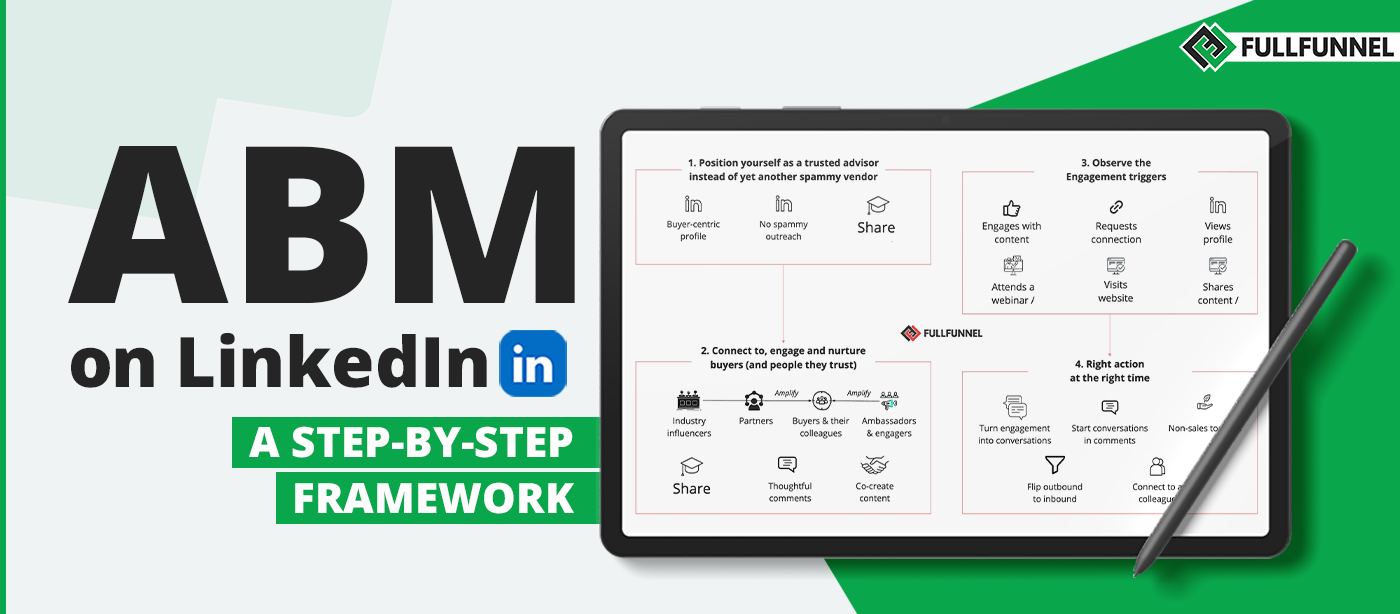In this article, I’ll share the step-by-step framework we used to create LinkedIn marketing programs that:
- Generated 9 enterprise opportunities (3 closed) in the first six months for Postindustria
- Transformed Wings4U from an unknown brand to a go-to-expert in customer advocacy and enter the US market (winning five deals)
- Tyk used to pilot, operationalize and scale the LinkedIn ABM process across their sales team, helping them not only start conversations and drive net new opportunities, but also helped their AEs nurture, engage and renew or expand existing high-value accounts
- Helped FullFunnel.io generate 200+ five-figure opportunities, and claim a position as a go-to brand when it comes to ABM and full-funnel marketing
Featured downloads (click on the link below to download):
7 Social Selling & Connection Scripts with 40%+ Response Rate.
5 common post types (and 22 examples) to never run out of post ideas
After reading this article, you will walk away with:
- Nine types of results you can expect to generate on LinkedIn, if you’re marketing and selling 5+ figure deals to mid-market or enterprise companies
- A clear process to drive awareness and demand with target accounts, and generate inbound inquiries
- A step-by-step content framework to quickly produce daily content that gets the attention of 5+ figure buyers, even if you’re not a copywriter
- Six strategies to engage target buyers, book discovery calls with buyers who are in the market, while nurturing the others
- A process to proactively grow your LinkedIn network, including target buyers and four amplification audiences
- Examples and templates to start conversations that get 40%+ response rates
Table of Contents
ToggleHow most B2B companies do LinkedIn marketing, and why it doesn’t work

1. They promote gated content or webinars, then send leads to sales
I reviewed a LinkedIn campaign that ran for 6 months. On the surface, it seemed quite successful:
1300+ leads, most matching the ICP criteria. Cost per lead was decent, given the audience and the platform.
But the CRM told a different story:
Even after 6 months, this campaign generated only 2 opportunities — and no sales whatsoever.
Here is why:
- LinkedIn is not an intent channel. People come to LinkedIn to connect, learn, or simply to distract themselves.
- A download or a webinar registration is NOT a buying intent.
- Five-step email sequence is NOT a nurture program.
Five+ figure buyers don’t download an e-book, and get “nurtured” into an opportunity with a 5-email sequence.
They start buying when the issues or opportunities become a strategic priority, ask their trusted network for recommendations, and buy from people they know, like and trust.
2. They send cold, low-intent traffic (or cold messages) promoting a demo / discovery call
If you’re running ads promoting sales calls on a low intent channel like LinkedIn (or sending generic cold messages), you are effectively wasting 97% of your budget.
Why?
Because only a small percent of your market is actively buying.
And when you do capture leads in the market, you still:
- Come too late into the buying journey, after your competitors have been positioning themselves and influencing the buying committee and their purchase criteria.
- Are perceived as one of many, a commodity.
- Have a low win rate, and high cost of sales.
In practice, only smaller, less complex deals get closed using this approach.
3. They promote content and company news on LinkedIn company page
The vast majority of B2B brands use LinkedIn to drop links to their website, promote events, and publish company news that delivers 0 value to buyers. The engagement and reach of these posts is extremely low, and impact even lower.
You need to reach buyers where they are, and share native, stand-out content they will share in places you cannot get to.
And the common advice doesn’t help, either
I wish fewer influencers and vendors would promote their specific approach as a silver bullet.
Here are four frequently shared types of advice—and how they fail to deliver the complete solution needed by the B2B companies selling 5+ figure deals.
“Put yourself out there and create a personal brand” (or “Turn your employees into an army of brand advocates”)
This advice is often promoted by personal brand course vendors, LinkedIn analytics and employee advocacy tools.
And when done within the right framework and with the right content strategy, using personal brands of key employees is a powerful tool.
Unfortunately, many well-meaning “employee advocacy” programs never gain traction. Most people are left wondering what steps to take to build their brand… and especially, how to turn it into sales opportunities. They end up comparing themselves to industry leaders, believing they need thousands of likes, views and followers.
“Set up automation and get leads on autopilot. It’s a numbers game.”
This advice is promoted by “growth hacking” consultants and vendors of LinkedIn automation tools. You’re just supposed to scrape your target buyer’s profiles, set an automated sequence, and wait for the “leads to come”.
But LinkedIn is not the Wild West it used to be. Using automation is the easiest way to get a lifetime ban from LinkedIn and earn a reputation of a spammer.
At best, you quickly burn out your market, and end up with a few “leads” that never become customers.
“Just ungate/share content, create value, and leads will come”
Creating content aligned with your best customer’s buyer journey is a cornerstone of a successful ABM on LinkedIn strategy.
Unfortunately, many teams are left wondering what content to create, and how long to wait until they’ll see the results.
The algorithm changes continuously, and slashes the organic reach and views of your posts. You end up sharing a few posts, struggling to get engagement and inbound inquiries you were hoping to get.
And even when teams get the budget and the buy-in to ungate their content, they still struggle to generate a predictable pipeline.
That’s because they often miss:
- A clarity on their ICP, and insights into their buying journey
- The right content strategy to capture the attention of target buyers and generate demand for your products
- Know-how on how to create content optimized for LinkedIn
- Approaches needed to nurture, accelerate and capture the demand. Passively waiting and hoping for your content to generate inbound inquiries leaves a LOT of money on the table.
“Just focus on building relationships”
Building relationships matters, because people buy from people they know, like and trust.
But the problem that people face here is: how to start conversations without being salesy, cut through the noise and get responses from busy decision makers?
What all of these approaches have in common
None of the common LinkedIn advice is wrong per se.
But the majority of advice ignores the complexity of the modern B2B buying process, and only offers a partial solution. A solution that only addresses some buyers during a small part of their buying journey.
The good news is that you don’t need to be on LinkedIn all day long, have 10,000+ followers, send 100s of messages, ungate all your content and burn through your budget with ads.
You just need the right framework that addresses the complete buyer journey.
In this article, I will share the LinkedIn marketing framework used by B2B companies to drive awareness and demand with target accounts, and generate opportunities with 5+ figure buyers who are in the market, while nurturing the others.
But before diving into the framework, let me share nine different types of results that you can expect from ABM on LinkedIn.
Nine types of results of ABM on LinkedIn
Result 1. Warm opportunities with highly targeted accounts
When you’re selling high-value enterprise deals, you don’t need a lot of customers, but you need the right customers. Since closing a large deal takes lots of time and resources, most companies cannot afford to waste 9–12 months on a deal with a 10% chance to win.
For example, for their pilot ABM on LinkedIn program, Postindustria included only 11 best-fit accounts from the AdTech vertical, matching account qualification criteria identified based on an extensive analysis of won and lost deals.
After consistently using the ABM on LinkedIn framework to generate awareness and demand with about 100+ target buyers from these 11 accounts, they landed sales-qualified opportunities with 9 of them (81%)—and closed 3, high 6-figure deals.
Result 2. Targeted brand awareness (even for unknown brands, or new markets)
Unless you’re a category leader, your brand might not be very well known by your ideal target accounts. LinkedIn marketing framework uses targeted distribution of expertise content and engagement techniques (such as thoughtful commenting), to educate buyers at target accounts, and position your brand as a go-to expert in your industry.
Example #1. We started FullFunnel.io as an unknown brand. Since then, we grew our following beyond 50k, generated 200+ five-figure opportunities, landed speaking gigs at dozens of leading events and podcasts, and positioned our brand as a go-to brand when it comes to ABM and full-funnel marketing. The major driver was consistent application of the ABM on LinkedIn framework.
Example #2. After growing organically, mainly through referrals, Wings4U decided to implement the ABM on LinkedIn framework as a way to enter the highly competitive US market. They started off with no visibility in the target market. After six months of running the ABM on LinkedIn program, they became a well recognized brand in the customer advocacy industry, and have landed five qualified deals in the US. Here is the recount of their experience with the ABM on LinkedIn framework:
Result 3. “Dark social” and awareness in the whole buying committee
Sharing expert content on LinkedIn allows you to be shared in places you cannot get to, and create awareness in the whole buying committee.
I recently closed a deal, having to speak to 5+ people from the buying committee. I was surprised when I discovered they all seem to know me, and what FullFunnel was all about. This was surprising, because I’ve never seen them on LinkedIn, on our community, at events etc.
What I learned later is that one of their colleagues was sharing our LinkedIn posts on the company Slack.
It was one of the easier deals to close.
The truth is that most important conversations happen outside your funnel. People ask for recommendations (and share information) from colleagues, via private chats on Slack or WhatsApp, and discover solutions from industry influencers.

Result 4. Nurturing the buyers with a complex buying process
We’ve analyzed our won and lost deals recently, and came to the following conclusions:
- About two thirds of clients mentioned they have heard about us from LinkedIn.
- Almost all Tier-1 clients were engaged with our LinkedIn content.
- Most of them say they saw our content in the newsfeed because somebody from their network engaged with it.
- Only one Tier-1 client came through a referral by an industry influencer (who referred us because he knew us through LinkedIn and our LinkedIn content).
Note that the above stats prove you need to build relationships not only with your target accounts and buyers, but also with industry thought leaders, peers, communities, and industry media (more on that in the section about the LinkedIn Ecosystem below). - Personalized non-sales nurture touches (like asking about feedback or inviting them to the webinars) helped to stay on top of their minds and remind them about us in an unobtrusive way.
- Timely outreach after noticing they had passed through our target engagement threshold on the website or content hub helped to accelerate the sales cycle with every second client.
- Our LinkedIn content, case studies, and webinars were shared on internal Slack or Teams chats, which created awareness across the entire buying committee.
- All inbound opportunities that came directly from Google search were either Tier-3 (lowest revenue potential), or were disqualified.
This all simply means that people buy from people they know, like, and trust. And that’s exactly why the continuous nurturing via LinkedIn was crucial for our success.
Result 5. Inbound pipeline and revenue
While it doesn’t happen quickly, after a consistent application of the ABM on LinkedIn framework, you will start to get inbound inquiries and opportunities with target accounts.
For example, about two thirds of our inbound pipeline mentioned they have heard about us from LinkedIn.

Result 6. Increased outreach efficiency with engagement-based triggers
The two biggest problems with cold outreach are:
- You don’t know them (you don’t really know if the recipient of your message is looking for the solution you’re offering)
- They don’t know you (people buy from people they know, like and trust).
Engagement-based outreach solves both of these problems. Engagement-based outreach means to reach out based on an engagement trigger (e.g. someone engaging with a piece of content). Here is an example:
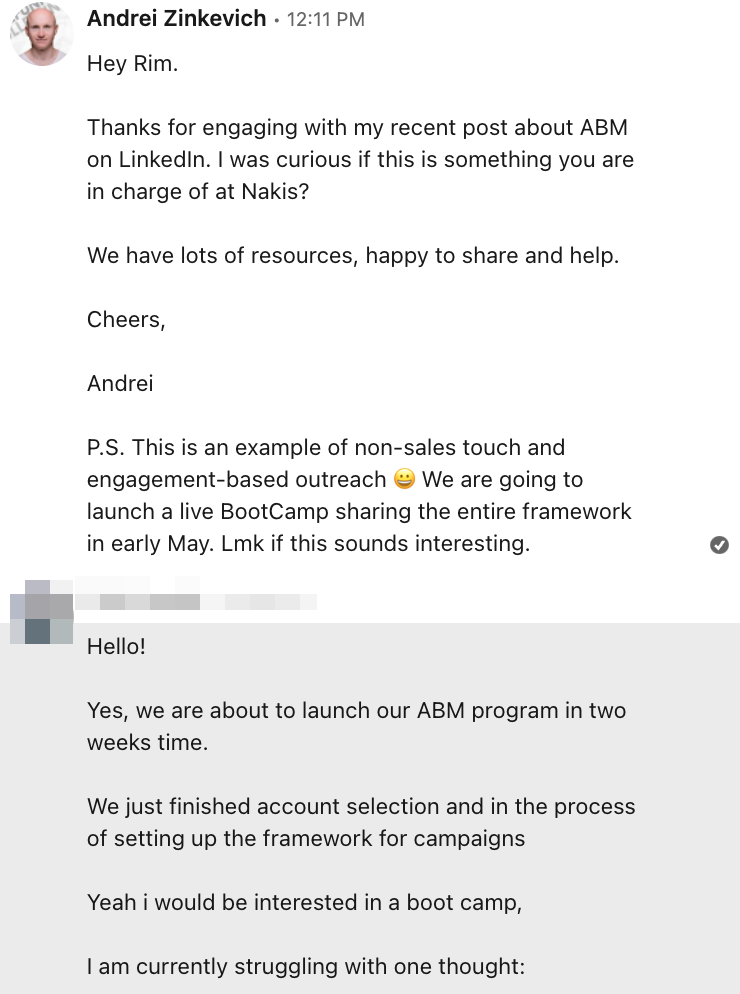
Using this approach, we regularly get acceptance rates of up to 80% and 40%+ response rates.

Result 7. Free PR and media requests
In two years after starting as an unknown brand, we were invited to speak at more than two dozen events and podcasts (including leading events like Ad World Conference and podcasts like B2B Growth). Our articles have been published by top brands in our niche, including Sales Hacker, CXL, Terminus and MarketingProfs.
Most of the invites came through LinkedIn.
Even after only four weeks, a couple of participants of the first ABM on LinkedIn Bootcamp got invites to speak at local niche media.


Result 8. Influencer Marketing Opportunities
Content collaborations are a secret weapon of fast-growing brands. Co-creating content with people and brands your buyers follow and trust is one of the fastest ways to grow your own audience and trust. Here are three examples:
- Identify key GTM regions and cities, and run events with local influencers (e.g. we ran ABM Days in Boston with Goldcast, Nick Bennett, Samantha Stone and Louis Blaut).
- Turn a podcast into a community event. While everyone records podcasts, we give our community an opportunity to interact with industry leaders live or get advice (e.g. live messaging teardowns by Peep Laja).
- Invite your best podcast guests as speakers on a virtual summit. We run a 5000+ subscriber summit every year, and our client used a summit as an ABM tactic to drive 34 qualified sales opportunities, closing five right off the bat.

That is why an essential part of the ABM on LinkedIn framework is building relationships not only with your target buyers, but also with partner brands and industry influencers (more about that in the LinkedIn Ecosystem section).
Result 9. Warm referrals by industry influencers
Warm referrals tend to have up to five times higher win rates, and 84% of B2B buyers begin the buyer’s journey with a referral. And the more trusted the person referring the vendor, the better the results are.
That is why, after building a relationship with industry influencers, they might refer you new business. This can be especially helpful if you are entering a new market where you’re still building credibility.

The ABM on LinkedIn Framework
The biggest mistake B2B companies make on LinkedIn is focusing on a few activities and missing the full picture. You need the complete framework to drive awareness & demand with target accounts, book calls with buyers ready to buy, while nurturing the others.
Here is the overview of the ABM on LinkedIn framework that I’ll break down in this article.

AWARENESS & DEMAND ACTIVITIES
1. Thought leadership and expertise content
Why?
- Generate demand for your product
- Prove niche expertise
- Position yourself as a trusted advisor
- Nurture target accounts
2. Thoughtful commenting
Why?
- Create awareness & attract attention
- Show your expertise
- Repurpose comments into posts
- Build relationships with influencers, partners and engagers
3. Paid content distribution
Why:
- See 1. Thought leadership
- Guaranteed distribution
4. Engaging with people, brands and media your buyers trust
Why:
- Regularly appear in the newsfeed of the target accounts
- Build a strong brand & a real relationship with the target audience
- Generate and capture the demand
- Educate & nurture the target market
5. Personalized connection requests
Why:
- Higher acceptance rate
- Opportunity to build a real relationship
- Targeted, 1-1 content distribution
ENGAGEMENT AND INTENT TRIGGERS
The awareness and demand activities generate a pool of engaged buyers. The buyers ready to buy will reach out to you (inbound opportunities).
Here is what to do with the others:
- Observe engagement and intent triggers (e.g. engagement with content, visiting your profile or inviting you to connect, visiting key pages on your website, content in your content hubs…). More on the intent data below.
- Turn the engagement into conversations, and accelerate demand generation and capturing with ABM warm-up and activation programs.
DEMAND ACCELERATION AND CAPTURING ACTIVITIES
The following is the subset of the ABM demand acceleration and capturing activities you can run on LinkedIn.
6. Engagement-based outreach
Why:
- Higher response rate
- Opportunity to get customer insights and see if there is a fit
- Build a relationship
7. Retarget with core offering, social proof and expertise
Why:
- Generate demand
- Nurture target buyers
- Generate inbound opportunities
8. Non-sales touches
Why:
- Stay top of their mind & nurture the audience
- Capture demand
9.Retarget highly engaged accounts with a strong CTA
Why:
- Capture the demand and generate more sales opportunities
- Don’t leave any money on the table
10. Thoughtful follow-ups and social “selling”
Why:
- Nurture the relationships
- Capture the demand and generate more sales opportunities
- Don’t leave any money on the table
Let’s break down the framework in more detail, and provide real life examples and case studies.
The LinkedIn Ecosystem: Five Audiences To Influence
If you’re selling 5+ figure deals, you don’t need a lot of customers, but you need the RIGHT customers who have the need for your product. Especially with large accounts, because most teams simply cannot afford to spend 9–12 months on a deal with a 10% chance to win.
That’s the main reason to use ABM as a strategic, targeted approach to:
- Generate opportunities with 21% of your target accounts*
- Accelerate pipeline and grow win rates by 48%*
- Prevent churn and expand your deals (171% higher ACV*)
*TOPO ABM benchmark study. ACV = annual contract value (deal size)
But to generate opportunities with 21% accounts, you cannot build large LinkedIn lists (or advertising audiences) based on a bunch of industries, company sizes, geographical regions and job titles.
With ABM on LinkedIn framework, you are:
- Targeting carefully curated accounts and buyers based on an Ideal Customer Profile (ICP)
- Maximizing your reach and influence via four amplification audiences.

1. Buyers from ICP Accounts
How do you select target accounts and buyers with a need for your product and a high chance of becoming your customers?
ABM uses the Ideal Customer Profile (ICP), a list of attributes that your BEST customers from a SPECIFIC market segment have in common.
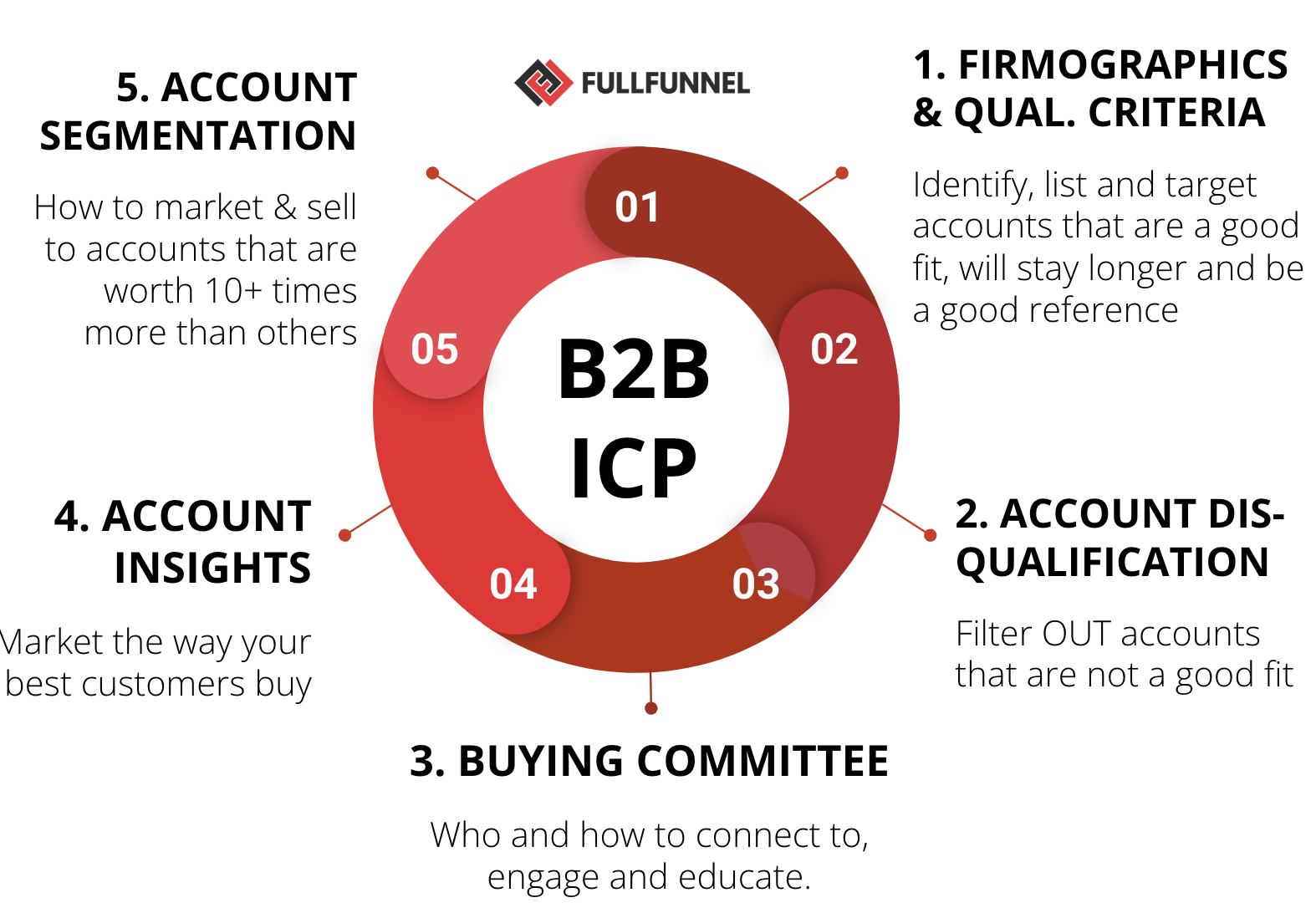
The ICP consists of:
- Account firmographics and detailed qualification criteria that help you identify, list and target accounts that are a good fit and have a need for your product
- Account disqualification criteria that help you filter OUT accounts that are not a good fit
- The buying committee members and their characteristics, that help you understand who and how to connect to, engage and educate. The more buyers you engage with and influence, the more:
- Insights you can get into the priorities, initiatives and purchase criteria
- Opportunities you’ll create and close
- You’ll understand what’s really going on with your deal
- Account insights (based on customer research), including the buying triggers, needs, goals and challenges, evaluation criteria, questions and objections, competitive alternatives, the reasons why they choose you and the value you create for them
- Account tier segmentation criteria and characteristics, that help you market and sell differently to accounts that are worth 10+ times more to you than others
With detailed ICP characteristics and criteria, you will be able to build a highly targeted account and buyer list. To stack the odds even more in your favor, use engagement and intent data to focus on the accounts who already know, like and trust you and are showing an interest in your solution (more about engagement and intent data below).

2. Engagers
Earlier, I mentioned that
- About two thirds of our inbound pipeline mentioned they have heard about us from LinkedIn. Almost all Tier-1 clients were engaged with our LinkedIn content.
- Most of them say they saw our content in the newsfeed because somebody from their network engaged with it.

That’s exactly why engagers are the second key audience you want to build and engage with.
Engagers are people from the industry who’re active on LinkedIn, connected to your buyers, and engage with your content—but will never become your customers. Buyers could discover your content thanks to a like or a comment by an engager they’re connected to.

Engagers are also important if you or your teammates have just started to post on LinkedIn. They will help with the initial engagement that LinkedIn’s algorithm like to see before showing your post to many other people.
In other words, one of the fastest ways to grow engagement on your posts (other than having relevant content), is to connect to, comment, and build relationships with engagers and industry influencers.
3. Industry Influencers
The fastest way to build audience and credibility, is to become associated with industry influencers. I previously mentioned examples of content co-creation (live podcast, summit) that helped us reach thousands of buyers during our first year, and our client land 34 qualified opportunities from a single event (Result 8 above).
That’s exactly why industry influencers are the third key audience you want to build and engage with. Industry influencers are vocal people from the industry your buyers follow and trust.
They can be:
- Local or global thought leaders, authors or speakers in your space
- Respected and outspoken industry leaders who get interviewed, or invited to speak at industry events
- Creators, people from the industry with a large social following (including your target buyers), actively engaging with and consuming their content
The relevance of the industry influencers is more important than the size of their audience. For example, if you’re selling a solution to manage risks of currency fluctuations to manufacturing CFOs, a respected foreign currency hedging consultant known in Illinois, could be a very relevant local industry influencer.
4. Partner Brands
Co-marketing with partner brands is another fast way to grow your audience. Both partners get access to the other partner’s audience.
For example, when FullFunnel has started, we quickly grew your audience with partnership webinars. We ran a series of webinars with MarTech brands like Sendoso and Chili Piper, adding 5000+ buyers to our audience, and generating four new deals.
That’s exactly why partner brands are the fourth key audience you want to build and engage with. Partner brands are companies selling non-competitive products to your ICP.
5. Niche Media and Communities
As I mentioned, being invited to speak to dozens of events and podcasts, and being published on top websites helped grow awareness and credibility of our brand.

In addition, today’s B2B buyers are asking for recommendations in industry communities.
That’s exactly why niche media editors and community owners are the fifth key audience you want to build and engage with. Examples:
- Podcast hosts
- Conference and event organizers
- Owners and highly engaged people in industry communities
- Industry association leaders
- Editors in industry news sites and magazines
The LinkedIn Profile Of A Trusted Advisor
Here are two biggest mistakes people make with LinkedIn profiles.
Mistake #1: Lack of clear positioning to a narrow audience.
“You cannot be everything to everyone. If you decide to go north, you cannot go south at the same time.” – Jeroen De Flander.
You want to get known by a specific audience (e.g. fintech SaaS) for helping them achieve a desirable result (e.g. reduce churn) better than others in the market (e.g. by 20%).
See, for example, how Andrei’s profile is narrowly positioned both in terms of audience (B2B tech companies with high ACV and long sales cycle) and expertise (ABM & full-funnel marketing).

Mistake #2: Treating your LinkedIn profile as a resume, instead of a landing page.
Your LinkedIn profile is your key piece of LinkedIn real estate.
When you become active on Linkedin, thousands of people will see your profile. People will look at your profile to decide if they want to accept your connection request, follow you — or consider working with you.
That’s why you need to treat your profile as a high-converting landing page. It should convey your positioning and value proposition, share social proof, demonstrate what you can accomplish for your prospects and call them to action.
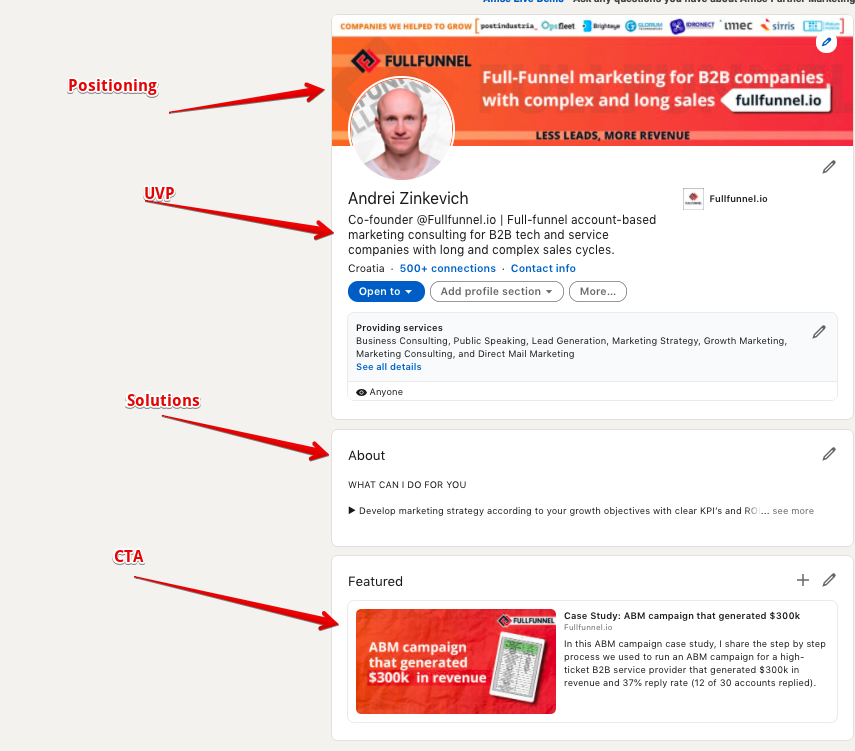

LinkedIn content framework to drive awareness and demand
The beauty of LinkedIn is that your buyers are already on the platform, ready to connect and learn. You don’t need to become a public speaker or a published author to drive niche thought leadership.
Put this simple content framework to practice, and start being taken seriously by 5+ figure buyers.
7 steps to nail the content topics your buyers won’t ignore
Here is the critical mistake that companies make when planning content: they base their decisions on keyword research and come up with ideas behind closed doors, using fictive personas (like “try-hard Tammy, the suburban mother of two…”).
But the key is to identify the topics in which your buyers are genuinely interested in.
In this section, I’ll share the brief overview of the process, but for more details, check out our buyer journey guide.

1. Customer research
From your deal analysis and customer interviews, extract:
- What triggered them to start their search? Why now?
- What strategic goals were behind it?
- Challenges they couldn’t solve on their own
- Steps they took
- Information they sought
- Critical questions, concerns or doubts
- Their evaluation and purchase criteria
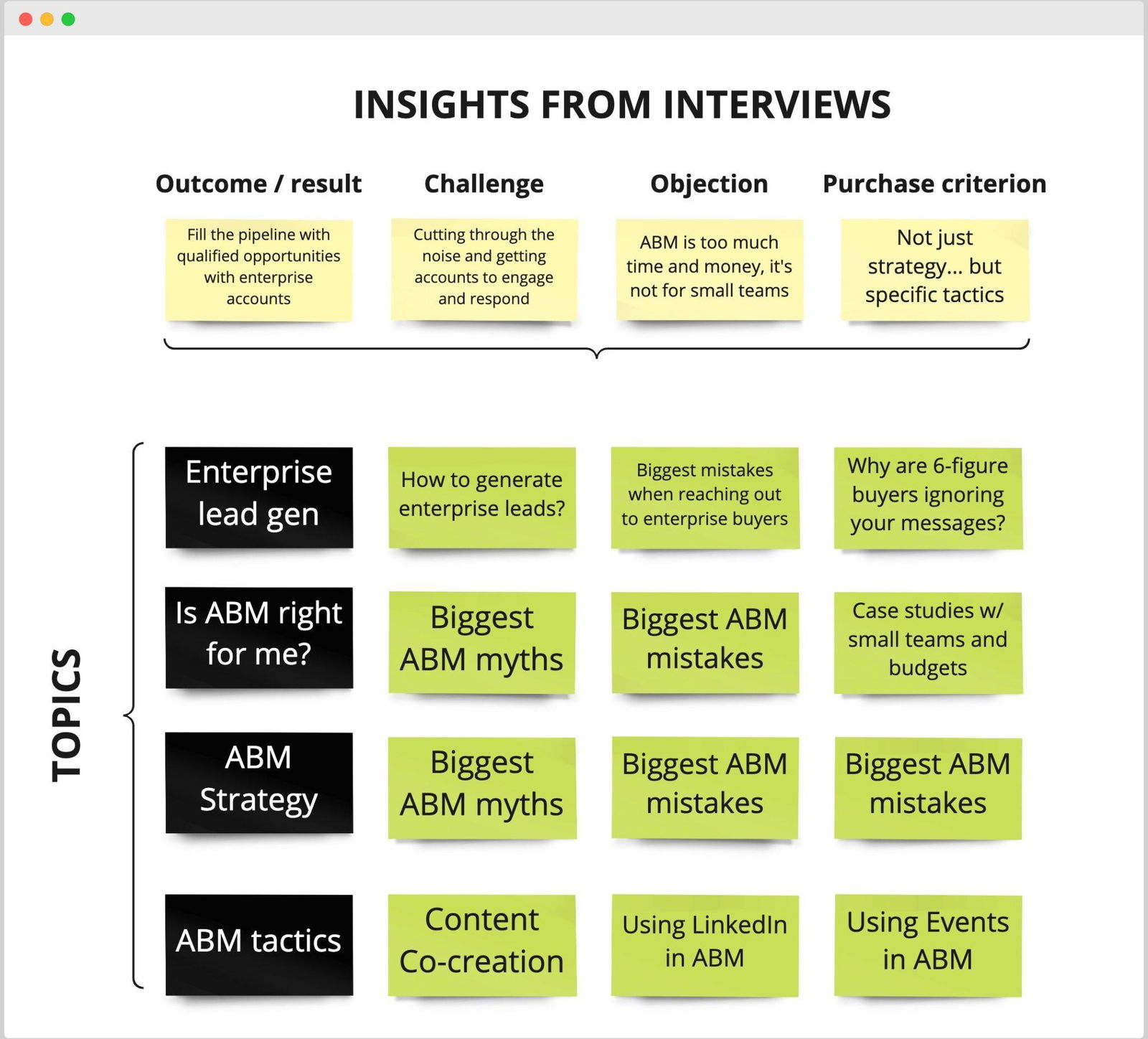
2. Map out the stages (beyond your funnel)
- Triggers
- Understanding the issues
- Exploring different types of solutions
- Evaluating vendors
- Making a decision

3. Collect buyer’s questions and objections
For each stage, collect:
- Who was involved
- What they were trying to learn and what questions they had
- Objections or concerns they had

4. Identify priority channels
Beyond the usual channels, include:
- Industry influencers and thought leaders
- Events and conferences
- Partner brands
- Industry influencers
- Communities
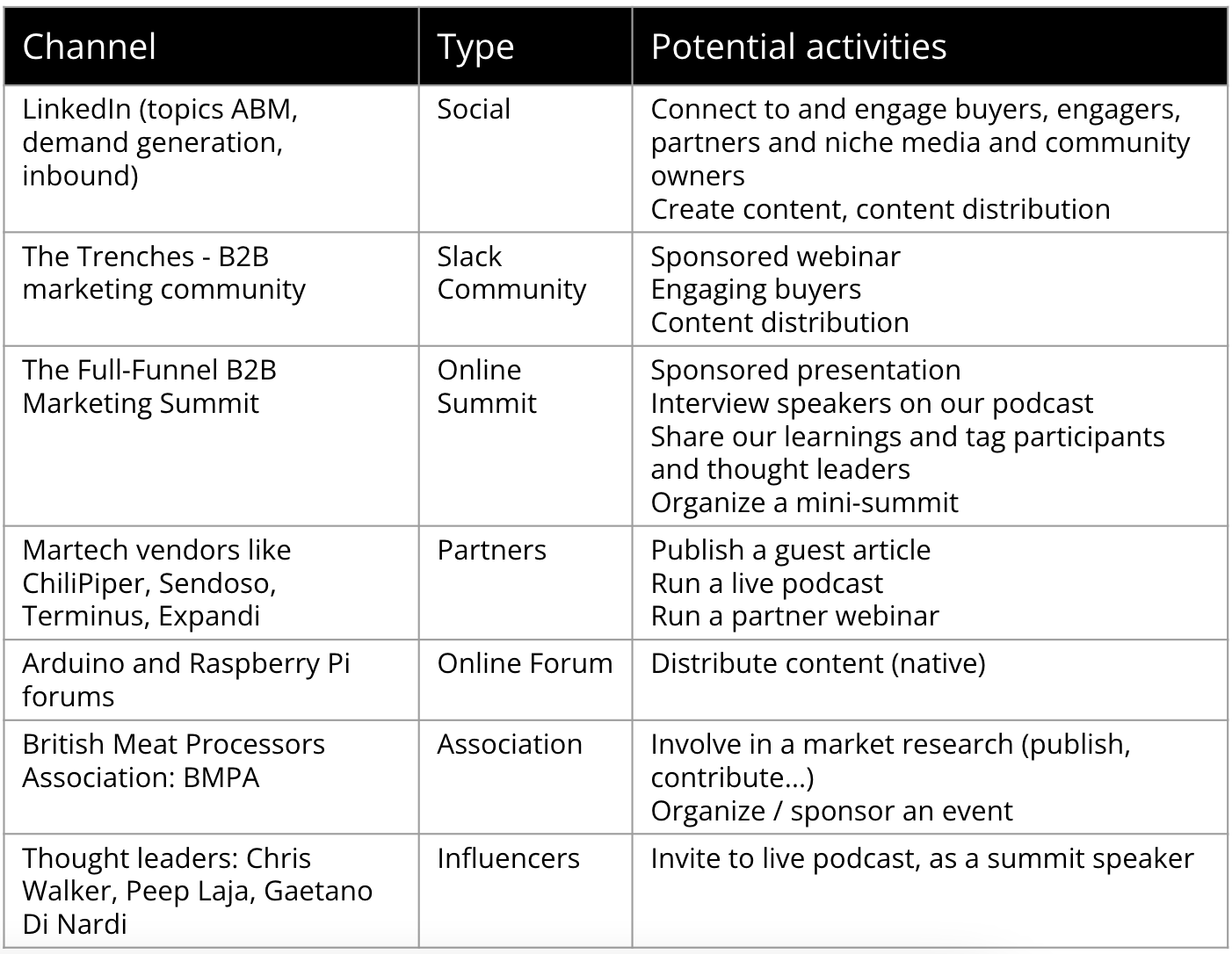
5. Extract the most common topics and questions
Check the channels, events and communities for additional topics and frequent questions.

Check the influencer’s posts and the comments and questions they’re getting.

6. Founder interviews
Interview your founders
- What are the companies in the target market currently doing wrong? What can they do better?
- Why did you decide to create the product? What is the gap you’re seeing in the market? Why do you think it happens?
- How do your potential customers solve these needs currently? What are the alternative methods? Why do they prefer to use them?
- What opportunities are they missing out on by relying on these alternatives?
- What do most competitors get wrong?
- What trends (technological, market, changes in consumer behavior, macroeconomic, political, regulatory…) make this switch urgent?
- What is your product vision? Where do you see the product evolving over the next 5 years? What is the big next thing in the market?
- What are the main ways in which different customers use your product?
- What are the outcomes they get? How are these outcomes are valuable?
- What insights do they get from the product — and how are these insights valuable?
7. Create a map of informational needs
Collect all the questions and topics (from 3, 5 & 6) in a map of informational needs. Map of Informational Needs is a document that summarizes all the topics, subtopics, and potential questions your buyers have as they move through the buying journey.
A Map of Informational Needs helps you avoid irrelevant content that gets ignored, and saves you from staring at a blank piece of paper thinking what to write about.

The 6-step LinkedIn content framework
Let’s give into the 6-step framework to consistently create LinkedIn content that attracts the attention of five and six-figure buyers — without spending too much time.
Download this cheat-sheet with 5 common post types (and 22 examples) to never run out of post ideas.
Step #1: Generate a post idea in < 2 minutes
Where people lose the most time with LinkedIn content is not knowing what to write about.
Never run out of LinkedIn post ideas with this simple content framework:
POST IDEA = TOPIC × POST TYPE
Here is how it works:
- Pick a topic that’s relevant to your buyers (from the map of informational needs)
- Pick a post type
Et voilà: you have a post idea.
Here are two examples of how this might work:
Example Post Idea #1
Topic = LinkedIn Content
Post type = How-To Post
Post idea = How to create content that doesn’t get ignored? (the complete post)
Example Post Idea #2
Topic = Buyer journey
Post type = Villain
Post idea = How companies market: Ad ➝ Gated content ➝ Sales follow-up. How buyers buy: (real example)… (the complete post)
Step #2: Jot a quick outline
The only thing you want to do here, is to quickly provide a list of steps or the main points.
That’s it. Just outline the main steps or points you want to make. Don’t worry about what you’ll put there yet. It can be as simple as in the following example:
Example LinkedIn Post Outline
Post idea = How to write LinkedIn Posts
Outline =
- Generate a post idea
- Outline the post
- Draft it
- Edit it
Step #3: Draft, quickly
Now, the key is to write quickly enough, “inner critic” doesn’t get a chance to question every word you write.
We’ll edit later.
Example LinkedIn Post Draft
Outline =
- Generate a post idea
- Outline the post
- Draft it
- Edit it
Draft =
1. Generate a post idea
Use this framework: POST IDEA = TOPIC × POST TYPE:
– Pick a topic (e.g. Buyer journey)
– Pick a post type (e.g. How-to)
– Generate an idea (How to map a buyer journey)
2. Outline the post
Quickly provide a list of steps or the main points.
For example, “How to write LinkedIn Posts”, the outline would be:
– Idea
– Outline
– Draft
– Edit
…
Step #4: Edit the opening
The most important part of your LinkedIn post is the opening: the visible part of your post that people see before they decide to read it.

A few example openings.
How to <solve a problem>/<achieve a desirable result>?

Old <topic>:… New <topic>:
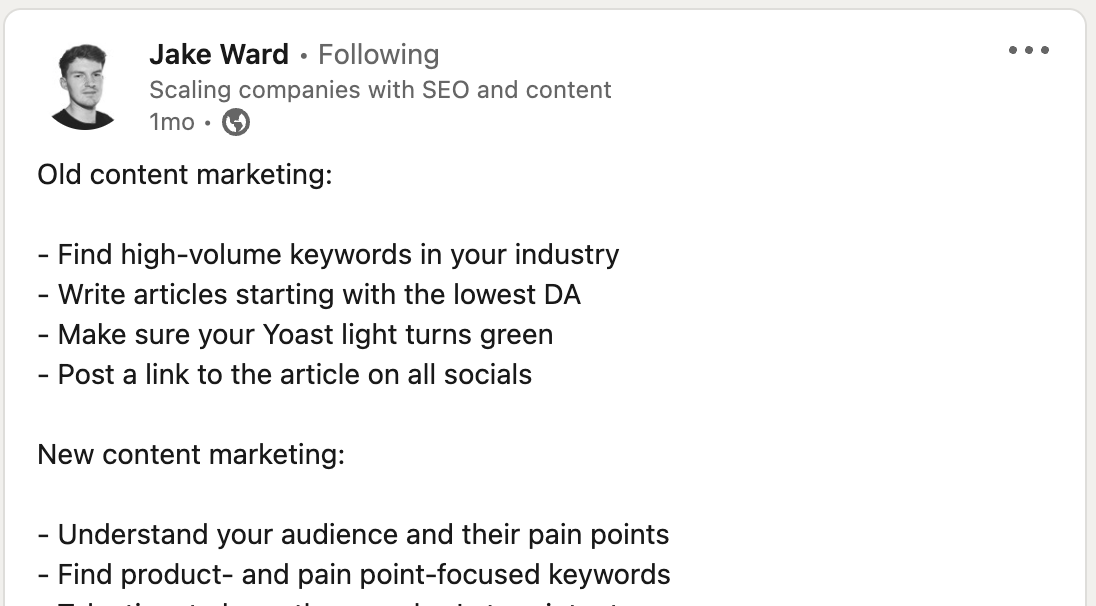
The reality of <topic> in <current year>:

Most <attempts to achieve a desirable result> fail for one reason:

Study the openings of viral LinkedIn posts and 5 common post types (with 22 examples), and practice by applying them to your posts.
Step #5: Edit the closing
Closing is the last part of the post, following your post’s main content. It’s a place to share a main point, takeaway or a conclusion.
Think of LinkedIn posts as sowing and watering seeds. You have the opportunity to gradually brand your key messages in the back of your buyer’s mind, over many touchpoints. The closing is where you can plant those seeds.

Step #6: Formatting & design
When it comes to formatting, think of making it easy for buyers to consume your content.
The most simple format is a pure text post, and is the easiest way to start. To make it easy for people to read it, you can:
- Structure your posts as steps, or mini-sections
- Use short paragraphs (1-2 sentences)
- Use short sentences
- Use lists (numbered or bulleted)
- Optionally, you can use mock-bold or italic text to add more structure

Here are other post formats you can use.
Carousels: these are PDF documents in portrait mode (1200 x 1500 pixels), using large fonts and a few pages on each page (think of making it easy for mobile users to consume the information).

Image posts. Avoid attaching a stock image, or image that’s otherwise not adding any value to the post. We like using diagrams, as the diagram itself gives a big picture overview of the complete framework we’re sharing in the post.

Video posts. One of the most famous examples of video posts are posts by Chris Walker. Each of his 3-5 minute videos, answers a key question, shares a framework or a case study.

Poll posts. These posts provide a low threshold engagement, and used to generate LOTS of views at a certain period. More interestingly, you can use polls to detect intent signals.

B2B Content Checklist
The majority of B2B content is boring, superficial, me-too content with no influence on the target buyers. The rest is salesy content about product features, masking as educational.
Your buyers don’t need MORE content. They need better, practical content that helps them see their issues in new ways, and answer specific questions and objections they have as they move through the buying process.
Here is a simple checklist that you can use to evaluate your posts.

If you’re following the first step of the above content framework (deriving post topics from the questions your buyers have as they move through the buying process), you’re all set on the first three criteria:
1. TARGETED AND SPECIFIC: You cannot be everything to everyone. A good piece of content needs to speak to a specific buyer and offer precise advice for a particular situation.
2. RELEVANT: Content is relevant when it addresses a top-of-mind issue or question that your buyers have.
3. ON-BRAND: Your content may be targeted and relevant, but fail to help you burn your key messages in the back of your buyers’ minds. For example, motivational posts could be relevant to your buyers but have nothing to do with the products you’re selling.
Here’s a quick overview of the last two criteria:
4. STAND-OUT: The web is full of superficial, me-too content. The best content:
- Offers practical, step-by-step frameworks you can actually apply
- Is concrete, not just theoretical (e.g. using real-world example)
- Is not afraid to challenge the status quo and popular opinions in your industry
- Has a unique style (e.g. we’re known for our diagrams, Chris Walker for his videos, and Josh Braun for his cold outreach and objection handling examples)
5. CREDIBLE: It’s easy to forget that the average online reader is mistrustful. Three ways to make your content more credible:
- Share detailed, behind-the-scene case studies of real customers (or even better, let the customers speak)
- Feature trusted influencers and thought leaders
- Share the data, sources, and the methodology behind it

How (not) to use AI tools like ChatGPT to create LinkedIn content
When ChatGPT hit LinkedIn, many people jumped on the wagon and our feeds became flooded with generic posts with obvious advice.
In other words, by simply asking ChatGPT “Write a LinkedIn post about …”, it will be difficult to stand out and create authoritative content.
At the same time, the generative AI tools are here to stay, and are rapidly becoming better. As marketers and salespeople, we cannot afford to ignore them.
So, with a risk of becoming quickly outdated, here are a few and experiences to help guide your experimentation with AI to improve your content production workflow.
Use ChatGPT to help with customer research
We’ve recently surveyed and interviewed 160+ B2B marketers working for brands with high ACV for our State of Full Funnel industry research. ChatGPT saved me a ton of time by analyzing and summarizing the findings. It did a great job.
What ChatGPT was NOT good at was replacing that research. In other words, when I asked the tool to “Act as a VP of marketing of a B2B tech company with high ACV and share the top challenges in current year”, the result did not reflect our findings at all (although it was more than happy to provide an answer that might seem accurate).
Use ChatGPT to come up with topics to post about
I found that simply asking ChatGPT to list content ideas, even when they are based on the research, still tends to produce generic and obvious ideas. For example:
- 5 Proven Tactics to Drive High-Quality B2B Leads
- The Power of Inbound Marketing for High ACV B2B Companies
- Maximizing Webinar ROI: Strategies for Generating High-Value B2B Leads
So, instead, I provided the insights from our research, and asked to “Act as a VP of marketing of a B2B tech company with high ACV and list the steps that you’re taking to analyze and understand your challenges, and questions you’re asking yourself along the way”. This resulted in somewhat deeper insights, and questions like:
- Is our content resonating with our target audience and driving engagement?
- How can we better align our marketing efforts with our buyer’s decision-making journey?
- How can we measure the success of our ABM initiatives?
I’ve actually written content about these topics, and it resonated well with our audience.
Now, you can take any of these topics, and ask ChatGPT to come up with more relevant and specific questions. For example, I asked to review the last question from above (about ABM metric), taking into account the insights from our research, and I got:
What metrics and KPIs should we track to measure the success of our ABM initiatives and demonstrate their impact on the overall pipeline and revenue?
Now, I know our buyers actually have this question, and it’s definitely worth creating a post about it.
Use ChatGPT to come up with post angles
ChatGPT is exceptional at helping you brainstorm and come up with new ideas. As a response to “Take question number 7, and come up with five LinkedIn post ideas”, I got a couple of interesting ones:
- How to Leverage ABM Metrics for Sales and Marketing Alignment
- Demonstrating the ROI of ABM: Tips for Reporting Success to Stakeholders
But I still wanted to get something more specific, so I just asked “I want the posts to be more specific, authoritative, and challenge the status quo”. More interesting ideas:
- Why Traditional Marketing Metrics Fall Short in ABM: The New KPIs You Should Be Tracking
- Beyond Conversion Rates: The Untapped Potential of Account-Level Attribution in ABM
- Why You Should Be Tracking Account Penetration Rate for ABM Success
- ABM’s Impact on Pipeline Velocity
Use ChatGPT for outlining
I really liked the angle of using ABM Metrics for sales and marketing alignment. So I tried two experiments.
In the first experiment, I tried to produce the draft of the post directly. ChatGPT came up with several interesting points (ways of using ABM metrics for marketing and sales alignment). But other points didn’t make much sense, or were quite generic, and would add a little value to the post.
That’s what made me realize is that I should first nail the main points of the post (=outline).
It came up with the following points:
- Select the right ABM metrics for collaboration
- Establish shared goals and targets
- Implement a data-driven feedback loop
- Align content and messaging for targeted accounts
- Use ABM metrics to refine lead scoring and qualification
- Foster a culture of continuous improvement
Great ideas. I wasn’t too happy with I wasn’t too happy with 3 and 6, so I gave ChatGPT feedback to rewrite it:
3. “Implement a data-driven feedback loop”. Make it practical by mentioning regular pipeline meetings, where the teams can share and discuss the main metrics, deals in the pipeline and how marketing can help, and where sales can share new insights,
6. “Foster a culture of continuous improvement”. Make it practical by mentioning postmortems and reviewing the metrics together with sales, to improve your ABM strategy, refine the ICP, content and messaging, and select more appropriate warm-up and activation plays.
Use ChatGPT for drafting. Then edit
When I asked the AI to produce the complete post, I wasn’t too happy with the end result. It still gave me good ideas, but I would end up rewriting most of the text to add more practical advice.
You can try providing more details on the kind of style and tone of voice to use—check out SEMrush’s tone of voice dimensions below.
Or you can actually paste your best-performing posts and ask ChatGPT to describe the tone of voice and style you use. Here is how ChatGPT described my style and tone of voice based on an example post I provided:
The tone of voice in the given text is direct, authoritative, and slightly informal. The style is concise, with a strong emphasis on practical advice and actionable insights. The author doesn’t shy away from presenting strong opinions and calling out common pitfalls in the B2B marketing landscape. The use of short sentences, numbered points, and bolded text allows for easy reading and highlights the main takeaways. The text also demonstrates empathy towards the reader’s challenges, acknowledging the difficulties they face and offering clear solutions.

Content Distribution and Repurposing
What’s the value of content, if it doesn’t get seen by your target buyers? None.
And yet, most teams focus 80% of their efforts on creating new content and distribution is done as an afterthought.
Let’s break down the role of LinkedIn in content distribution and repurposing.
For a more detailed guide on content distribution, check out the Content Distribution section of our demand generation guide.
The Core Content Pillar
Start by establishing one content pillar. In this context, the pillar mans the content channel and format that you will focus on most of your content production activities on.
For example, Chris Walker uses his podcast as a core pillar, and derives most of his LinkedIn content from the recorded episodes.
Our main pillar is daily content creation for LinkedIn.
Why?
Because creating content for LinkedIn:
- Is fast. It’s easier to write a LinkedIn post than a blog article or record a YouTube video
- It reaches our buyers fast, and the feedback is immediate. We see what resonates. This way we can double down on proven topics, and create long-form content with confidence
- It provides opportunities to start conversations in DMs, get feedback and insight (and build relationships with target buyers, which can drive sales opportunities)
As a consequence, we know what long-form content to focus on, have a stream of content to repurpose for our “always on” demand generation calendar, and LinkedIn drives most of our inbound pipeline.
The Content Distribution and Repurposing Flywheel
We use a simple calendar of regular marketing activities, to create an “we see you guys everywhere” effect in our market.

How?
Most of the content we produce is repurposed. For example, this article has recycled at least 10 different LinkedIn posts that have been proven to resonate with our audience.

Here is an overview of our repurposing flywheel:
- Andrei takes our best-performing posts and expands on them in our newsletter, which grew to 13k+ subscribers without any promotion, just because of the quality of our content.
- Our LinkedIn content also helps us build key relationships with influencers, who we then invite to be guests on our live podcasts. We parley these relationships into speakers for our annual Full-Funnel B2B Marketing Summit.
- We use Trenches, B2B Marketing Community, to distribute content, promote our live podcasts and events, but also get insights into the most frequent questions our LinkedIn posts should answer
- We then repurpose the most interesting discussions, live podcasts and summit speeches as issues of the Trenches newsletter
- We know what topics to focus on in our monthly webinars with 1000+ subscribers, and our in-depth articles where we share our frameworks and case studies
- We promote all major events and long-form content via LinkedIn, our newsletter and the Trenches community
17 LinkedIn Content Repurposing Examples
Check out this deck with 17 examples of how to repurpose LinkedIn content:
Organic Engagement And Social Selling Strategies
Download 7 Social Selling & Connection Scripts with 40%+ Response Rate.
People buy from people they know, like, and trust. A unique advantage of LinkedIn is the opportunity for your sales and marketing people to build relationships with the target buyers and influencers in your industry.
Here is how.
Proactively Build Your Network
Here are three common mistakes that B2B companies make when trying to proactively build their network.
Mistake #1: Invites without a personalized message
You might have heard the advice that you need to send invitations without adding a personalized message, because you might get a higher acceptance rate.
But this advice misses the key point of connecting: starting conversations and building relationships.
Just look at the stats from a few connection campaigns I ran—up to 60% of people responded to the personalized massage I used while connecting.

Now, adding a personalized message does NOT mean saying something like “Hey {first}, I saw we’re both in B2B marketing…”. People see through this and ignore these kinds of invites.
The easiest way to personalize your invite is based on their interest or a piece of content they engaged with or shared.
Based on a post they liked from a colleague or an influencer
Bob, saw your reaction on Nick Bennet’s post about account-based marketing KPI’s.
Love Nick’s content, and had fun running the ABM days in Boston with him.
My light bulb went off when he spoke about the expansion KPIs. Which KPIs resonated with you?
Based on their interest:
Hey Bob,
Great news about Panthers signing Beers, I hope this is the year FIU makes a run for the conference championship.
I’m connecting with retail leaders and sharing their success stories, like Acme’s legendary customer service.
Been in retail since 2010,
Alice
If you’d like more examples, check out our 7 Social Selling & Connection Scripts with 40%+ Response Rate.
To get even better results, check the Mistake #2, and the section about “Turning Engagement into Conversations”.
Mistake #2: Using AI to generate invitation scripts
If you ask ChatGPT to create a generic invitation script for a target role, they will see you coming from a mile away and will ignore you:

A better approach is to provide more data about the specific target that ChatGPT can use to personalize the invitation:
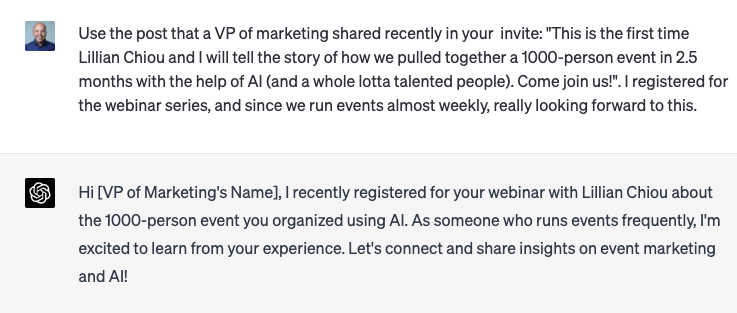
This is better, but I would do it differently:
Hi Meghan,
Just registered for your AI event planning webinar. Really looking to learn more, as we run events weekly.
Will you share the recording? I ask as the webinar’s at the time I’m putting my 7-year-old to bed. 🥱
Looking forward to your talk,
Vlad
If she accepts, we can then have a chat about how their clients (and her company) use events as a part of their GTM strategy, I can offer to share a case study, etc.
After trying different approaches, I came to the following conclusions:
- For the personalization to be effective, you need to provide the information about the prospect firs
- ChatGPT creates salesy invites, but it can quickly generate personalization ideas, based on the information you shared. Just ask for 10 ideas, pick the pieces you like the best and draft quickly
Mistake #3: Skipping the warm-up
The number one criterion people use to decide whether to ignore a message or an invitation to connect? They first ask themselves: do I know this person?
That’s why warming up before connecting is a very effective strategy. For example, you can use thoughtful commenting (see below), or create targeted posts featuring the target accounts or buyers, like on the example below.

Mistake #4: Only connecting with decision makers
Everyone wants to connect to C-suite, as they often have the biggest influence over the final decision. But there are three problems with this approach:
- Decision-makers are notoriously busy
- Since everyone is trying to get their attention, they’ve learned to ignore most messages and connection requests
- Most decision makers are not interested in your solution. They’re looking at the strategic goals and are focused on future. They make decisions based on strategic priorities and recommendations by their people who are doing the research
When selling 5+ figure deals, you’re usually selling into the buying committee. By connecting to all buyers, you’re increasing your influence (and insights you can get about the target accounts).
And since LinkedIn is a social network, and people are influenced by their trusted connections, you need to expand your network with five strategic audiences, as explained in the section above about the LinkedIn Ecosystem.
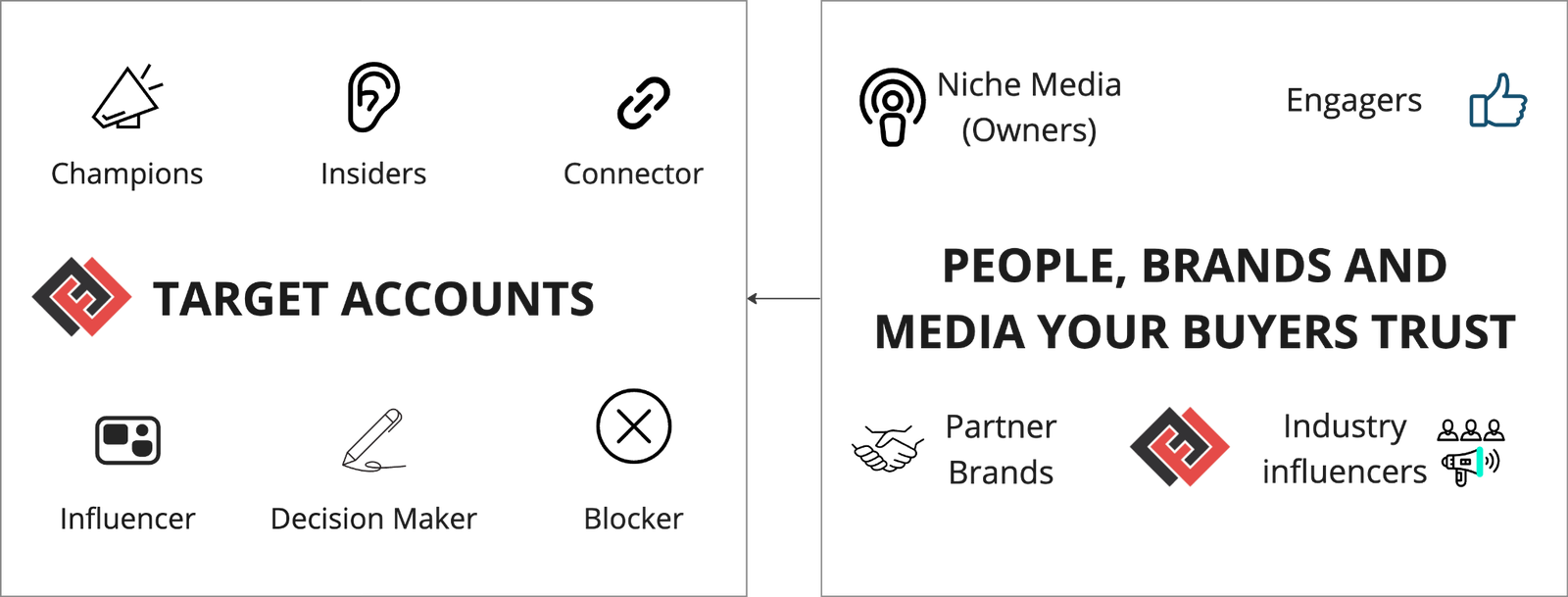
Mistake #5: Pitch slap
5+ figure B2B is not transactional, and 5+ figure buyers don’t buy because a random rep cold messaged them on LinkedIn. The truth is that:
- You don’t know them. If they didn’t give you an indication they’re buying, there is a 95% or larger chance they’re not and are NOT interested in your product.
- They don’t know you. Remember: people buy from people they know, like, and trust.
By cold-pitching early, you’re burning bridges before you’ve even built them.
Share Thoughtful Comments
Thoughtful commenting is the most underutilized tactics on LinkedIn. Here are five reasons why you should make thoughtful commenting a part of your ABM on LinkedIn process.
1. Warm-up target buyers
The easiest way to connect to a buyer is to start the conversation in the comments, and then move it to the inbox.

2. Create awareness & attract attention
Treat each comment as a small post, and you can drive awareness and attract attention, not only from your own followers, but also from the followers of the person whose post you’re commenting on.
It’s not unusual for a well-thought-out comment (placed early on posts that are getting traction) to generate as many followers as a well-performing post.
In addition, you’ll be able to repurpose your comment as a standalone post.

3. Engage your audience
It’s easy to build connections on LinkedIn. It can even be automated. However, connections and followers ≠ engaged audience.
Just look at the two examples below, one with 13.6K followers (probably connections built through automation), and the other with 2.2K followers. Despite having five times fewer followers, the second account has a much more engaged audience.

The fastest way to build an engaged audience is by sharing thoughtful comments on their posts.
4. Grow engagement and views of your posts
When you start sharing content, it’s very likely that the initial reach (views) and engagement (likes & comments) will be very limited.
Other than creating relevant content, the fastest way to build engagement around your own content is to comment on posts of people from the industry active on the platform.
Turning Engagement into Conversations
Engagement-based outreaching is connecting or messaging people based on their engagement with your content. This tactic is the best way to start a conversation on LinkedIn. Just look at the example response and acceptance rates:

Important: someone’s engagement with your content is NOT a buying intent. No pitch slaps! Imagine meeting someone you like at a party—would you ask their hand in marriage? I hope not. The best outcome would be having a great conversation, and keeping the door open for future conversations.
A couple of things that are appropriate to do based on someone’s engagement with your content.
Offer more content on the post topic.

…

Start a conversation about the post topic.
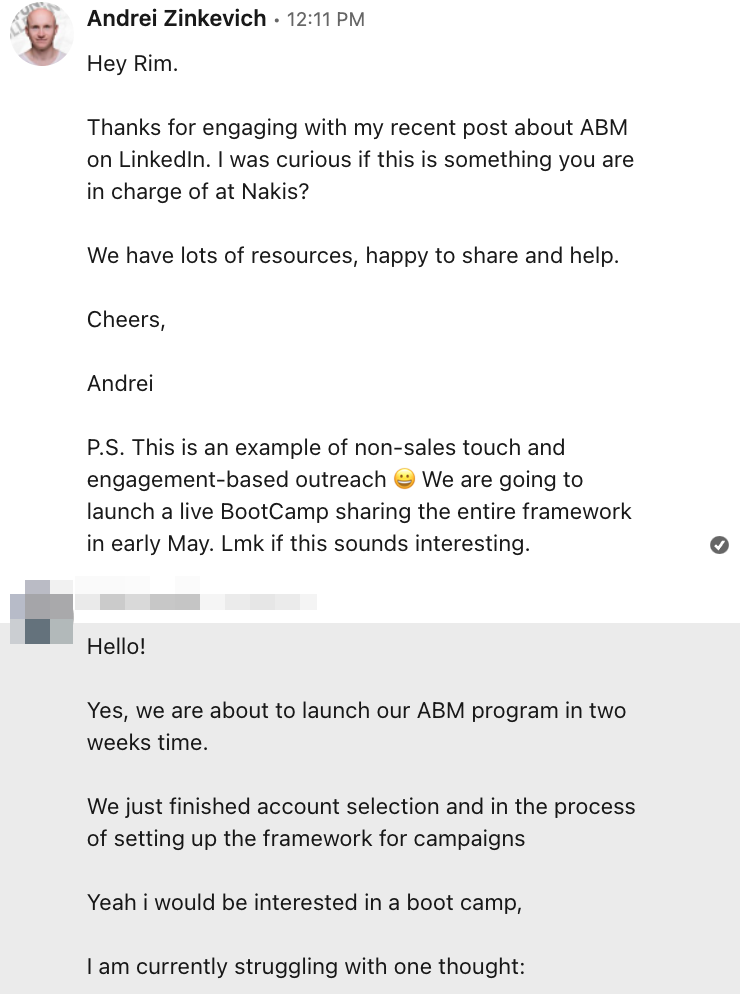
LinkedIn Events
LinkedIn Events allow you to get people from LinkedIn to easily register for your events, webinars—and even host your events on LinkedIn (using the “LinkedIn Live” feature).

Here are three ways you can leverage events to engage your target buyers.
1. Using LinkedIn To Drive Event Signups
As of this writing, LinkedIn allows you to invite up to 1000 of your first-level connections to register for the event.

The best way to promote events on LinkedIn, is using your content. And I don’t mean, creating a post that teases with a promise of what people will learn in your event. There are just too many events and too much content on offering for this tactic to work. Instead, create an expertise post on the same topic, and add the invite to event at the bottom.

Another way to promote your event using content is with engagement-based outreach.

2. Using LinkedIn to Increase Attendance Rate
Getting someone to sign-up for your event is just a beginning. Your next goal is to get people to actually show up to your event. LinkedIn helps here a bit, as it does send reminders as notifications.
In addition, you can reach out to the registered buyers, share a specific benefit of attending the event, or ask them a question.

You’re not only adding a touchpoint and increasing the attendance rates, but also creating another opportunity to start a conversation. For example, if you ask them about what they’re looking to learn at the event, you can either:
- Get into a conversation about it right away
- Use this insight to personalize your event follow-up, which will increase your response rate
Using LinkedIn to follow up after events
Event attendance ≠ buying intent. That’s why it doesn’t make sense to reach out to people, offering them to “hop on a call” where you’ll demo your product. Instead, ask their feedback, and if they’re planning to implement what they’ve learned.

Using Others’ Events
Event attendance indicates an interest in your topic, and sometimes even a buying intent. For example, during a session with a client, we discovered a relevant industry event on LinkedIn, and saw a decision maker from an ICP account among the people who registered. And here’s the kicker:
- The target account had a closed lost deal in the CRM because at the time, the prospect didn’t show much interest
- But six months later, the decision maker was attending the competitor’s event, and several people from the target account were checking our client’s high intent pages
You can easily search for relevant LinkedIn events in your industry, join them, and connect to people who registered.

Social “Selling” (Relationship Building via LinkedIn Inbox)
If you’ve done a good job with driving awareness and engagement, you’ve earned the attention of the buyers, and can now build a relationship. The principle is still the same: don’t propose on a first date. Instead, offer to take the relationship to the next (appropriate) level, while leaving the buyer in control.
Because, here is the truth of complex B2B sales: it may take months, if not years, before their priorities shift and your solution might become relevant.
Demand is built over time and multiple touchpoints in the buying journey.
Here is a detailed example of how this might look like:
Intent Data and Activation
Many marketing thought leaders share advice that, when taken at face value (or out of context), can be hurtful. Advice like:
“Just show up create value, and the leads will come”
“Just ungate your content, and optimize for native consumption”
“You cannot measure dark social, no need to obsess about attribution, just be patient and trust the process”
And while a percent of buyers that are ready to buy will reach out to you, or book a demo on your website, taking a passive approach means leaving LOTS of money on the table. Just check the social “selling” case study above. On the one hand, the demand was generated by sharing content and engaging the buyer, many of the touchpoints that eventually led to the discovery call were proactive. And many of those were based on previous engagement.
This is exactly the role of intent data. Intent data helps you identify accounts that are actively consuming relevant content, engaging with your brand, and are potentially actively searching with a solution like yours.
And while a deep dive into intent data and its role in ABM is out of the scope of this article, here are two main intent data takeaways related specifically to ABM on LinkedIn, and a detailed case study in case you want to dive deeper into the topic.
Engagement Data on LinkedIn
LinkedIn provides you many engagement triggers:
- Engagement with your content
- Engagement with relevant content shared by others
- Registration for a LinkedIn event (yours or someone else’s)
- A visit to your profile
- Invite to connect
- LinkedIn Sales Navigator alerts, including alerts about buyers, or “leads” you’ve saved (engagements, recent posts, news, job changes) and alerts about saved target accounts (growth, new decision makers, news, posts and risks).

What Makes LinkedIn Engagement Data Different
And unlike the other sources of engagement and intent data that only provide you information about engaged accounts, on LinkedIn, you can identify the individual engaged buyers, and use LinkedIn commenting and messaging to start conversations and build relationships (see the Organic Engagement Strategies above).
Intent Data Case Study
There are many more sources of intent data, and ways to use it within your ABM Strategy that go beyond the scope of this article. However, LinkedIn plays a major role in engaging and driving conversations with the target accounts selected based on intent data. That’s why I’ll include a case study of how we used intent data to generate a Tier-1 opportunity in 50 minutes, live on stage (during a session of our Full-Funnel Summit):
Sales and marketing execution alignment
Some of the most frequent questions we get are about the role of different revenue teams:
- What is the role of marketing in organic LinkedIn engagement?
- What is the role of sales in awareness and demand creation?
- How can these teams collaborate and support each other?
In other words, how to align the two teams on the execution level?
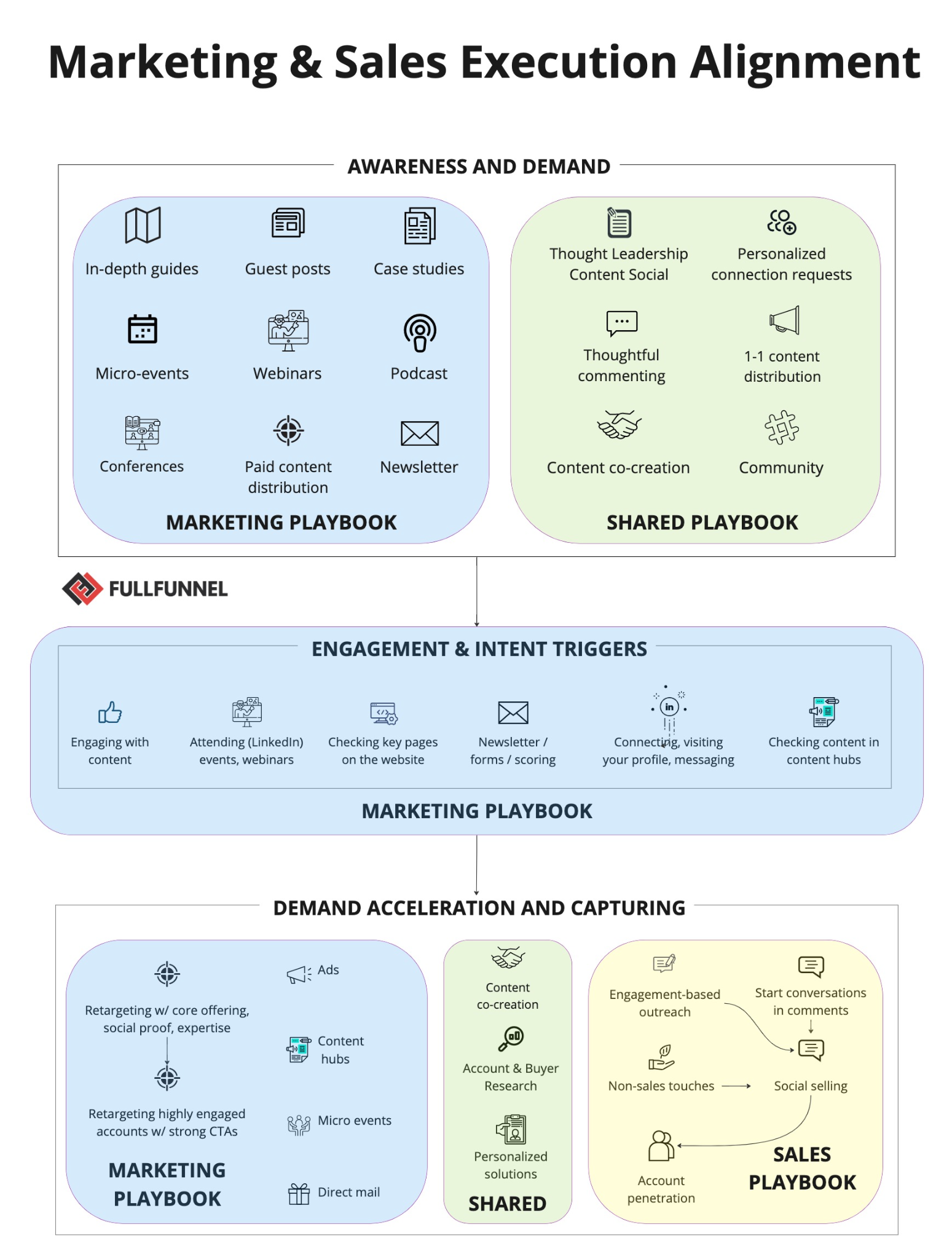
Target alignment
If you’re selling 5+ figure deals, sales and marketing need to be aligned on:
- The priority market segments and regions
- Account (dis)qualification criteria
- Buying committee structure
- Buying journey and buyer informational needs
- Messaging
In other words, the teams need to be aligned on the key elements of the GTM strategy.
Alignment in awareness & demand activities
Driving awareness and demand with target accounts is primarily the marketing function.
However, sales can play a key role in educating and engaging multiple buyers in high-value, ICP accounts.
Here’s how:
- Salespeople can repurpose and share social content from their own profiles. This allows them to position themselves as a trusted advisor instead of yet another rep, and create opportunities for engagement-based outreach
- Thoughtful commenting, to create awareness & attract attention, and move from comments into the DM.
- Personalized connection requests to target buyers from high value, ICP accounts, to get a higher acceptance rate, and start more conversations
Should salespeople create content for LinkedIn?
While content creation is primarily a marketing role, depending on the content team for all the content can create bottlenecks, and introduce a disconnect between the first-hand insights salespeople have, and the content that’s being created.
However, there are several challenges that sales teams face in content creation:
- Subject-matter expertise to create content valuable for their ICP
- A company that encourages employees publically posting about topics related to the company
- Time to curate an audience
- It isn’t enough to just repost a company blog post
- Wrong KPIs (e.g. # of dials, cold messages…)
- Pipeline pressure & short-term company mindset
Here are the possible solutions:
- Assign someone from the content team to prepare content for sales to avoid bottlenecks, and to work closely with the salespeople to avoid the disconnect with the target audience
- Repurpose, A LOT. Each post that does well can be repurposed in various formats, and reposted on different profiles (spread in time)
- Creating posts based on industry news, or even better, based on account news. Bonus: each post is an opportunity to connect and start a chat.
- Have an executive / SME lead by example
- Start with a “change agent”. Start with a highly motivated and engaged salesperson, within a scoped pilot. Adapt the KPIs. The best way to get other salespeople interested is to show results.
- Create a playbook. Based on the pilot, create a playbook, including:
- Training on how to grow the audience
- A custom content framework, incl. (1) post types and formats that work well for them (2) a list of buyer topics and questions to address in posts (3) a vault of existing content they can repurpose
- Scripts & examples for engagement-based outreach, and 1-1 content distribution
- Get good at summarizing content from SMEs
Demand acceleration and capturing
Most of the organic engagement and social selling strategies can be executed by the selected members of the sales team.
Here is the role that marketing can play here:
- Perform similar activities focused on building relationships with partner brands and industry influencers (with the aim of creating co-marketing opportunities)
- Prepare content and content hubs for each key topic, that sales can share in 1-1 conversations
- Collecting and processing engagement and intent data, and sharing the insights about engaged accounts with sales
Paid Content Distribution And Retargeting
Most B2B companies waste money on ads that send cold audiences to a “book a demo” landing page, or promote gated content.

I broke down the problems with both of these approaches in the section titled “How most B2B companies use LinkedIn, and why it doesn’t work”.
But here’s the gist: B2B buying process is not transactional.
B2B marketers need to learn the value of a touchpoint without a conversion. Not everything needs a click, a form fill, or a download.
Demand generation is built over time, and across many touchpoints in the buying journey.
That’s why the Justin Rowe’s LinkedIn Ads Framework nurtures buyers over six months, and over many touchpoints. The ROI of this approach? 650%.

Tune in to listen to Justin break down his full framework during our Full-Funnel B2B Marketing Summit:
How To Gradually Introduce The ABM on LinkedIn Framework in Your Organization
The most common approaches that companies take with LinkedIn:
-
- Hire an agency to run LinkedIn ads based on a briefing
- Give the sales team “social selling” training
- Implement a top-down employee advocacy program or a tool, expecting the employees to share and engage with company posts
All of these approaches miss important steps. Here is the framework we like to use.

0. Strategy and buy-in
Here is an overview of the main activities at this stage :
- Decide on the target industry, verticals and geography
- Develop a detailed ICP, including (dis)qualification criteria
- Map out the topics and questions your buyers have as they move through the buying process (the map of informational needs)
- Define the priority goals, and choose one goal for the pilot campaign (e.g. net-new account development, accelerating the pipeline, renewal or deal expansion)
- Depending on the goal, define leading indicators and KPIs that you will use to measure the success of the program
- Get the buy in for a small-scoped pilot (see below)
For more information, check out our ABM Strategy guide.
1. Pilot
Follow the 1-1-1-1-1-1-10 framework:
- 1 market (focus on an industry vertical within a single geographical region)
- 1 SDR
- 1 marketer
- 1 content type (e.g. text posts)
- 1 source of intent data for target list building
- 1 goal (expansion, net new revenue, acceleration, renewal)
- 10 accounts (3 buying committee members per account), maximum
Why?
The pilot campaign is an experiment.
You’ll inevitably make hypotheses about your ICP, content strategy and messaging. During the pilot, you will be validating and figuring out what resonates with your audience.
The goal is to launch a campaign fast with minimum resources to avoid losing momentum and trust from execs and sales.
2. Operationalize
The goal of this stage is to turn the pilot into an evergreen process. During this phase, you’ll be documenting and refining your process. Before scaling the efforts (and especially, before involving more salespeople), you want to make sure you have a documented playbook that has proven to work.
If you have the resources and the marketing budget, you can also build out the complete full-funnel paid strategy, including the cold and different retargeting layers.
3. Scale
You can scale the ABM on LinkedIn program by:
- Training and onboarding more sales people, addressing more territories, accounts and goals (expansion, net new revenue, acceleration, renewal)
- Scaling the paid strategy
But LinkedIn on ABM should not be treated as a standalone program. The best ROI is to be made when you integrate it within the ongoing marketing and sales operations. LinkedIn can play a role at indifferent stages of an integrated full-funnel marketing program, described in the section “Merging ABM with demand generation: a cohesive model” of our ABM Strategy guide.
Evergreen ABM on LinkedIn Process
As powerful as the ABM on LinkedIn framework can be, the results don’t come overnight, or from sporadic activities. It takes an ongoing, consistent application of the key activities to start generating significant results.
Why?
Because, each time you share content or engage your key audiences, you’re growing your key assets:
- Brand
- Awareness
- Relationships, trust and authority
- Skills
- Understanding of your target audience
- Your partnerships
Each of these key assets have a multiplication effect on everything you do. So with time, your audience AND your results, start growing exponentially.

Another common challenge is skipping parts of the framework, and focusing only on a subset of activities.
Lack of consistency and skipping key activities are at the root cause of the most common issues teams face on LinkedIn. Here are a few examples of common issues and the related root-causes:
Issue: Low engagement. Common root-causes:
- Content not based on customer research and insights into topics and questions buyers have as they move through the buying journey.
- Small / irrelevant network (lack of proactive network building).
- Not engaging with the LinkedIn ecosystem (one of the fastest way to grow engagement).
Issue: Low acceptance response rates. Common root-causes:
- Lack of awareness activities (content, comments).
- Lack of personalization.
- Lack of warm-up and engagement before connecting.
Issue: Engagement and conversations that never lead to opportunities. Common root-causes:
- Content not based on customer research and insights into topics and questions buyers have as they move through the buying journey.
- Lack of non-sales touchpoints.
- Lack of account and buyer research and personalization
- Lack of engagement and intent data strategy, and engagement-based outreach
Here are several practical solutions to help teams in consistent execution.
Weekly Pillars
Many teams struggle with consistency. One tool that we found effective are weekly pillars from Brian Margolis’ productivity strategy
Pillars are high-impact, measurable activities, like posting or commenting on LinkedIn. When you complete these pillars consistently, you build an unshakable habit, while still having the flexibility to adapt as circumstances change.
You start by setting weekly objectives, such as “connect to 10 ICP buyers and share 5 thoughtful comments each week”. With each week, you can add an activity, or increase frequency, until you reach a cadence that works for you.
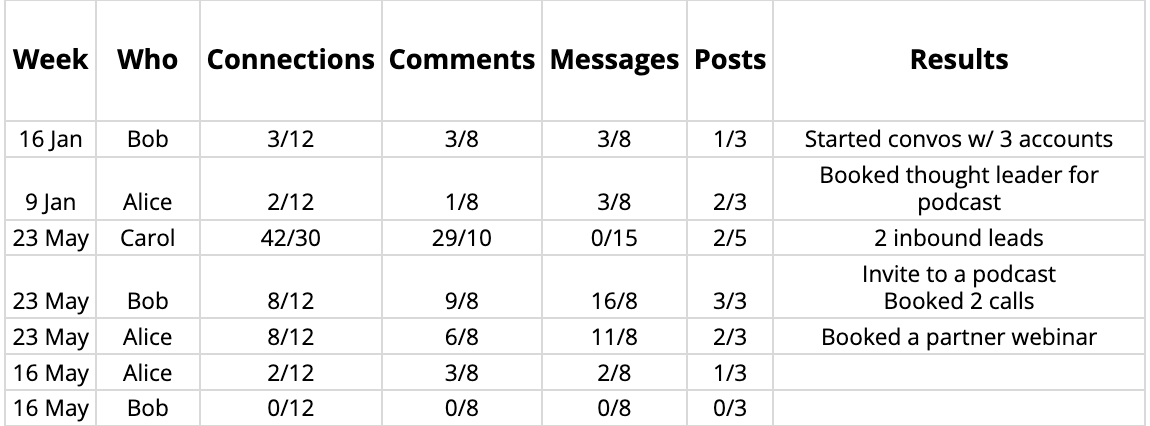
Internal Community
Some of our clients have engaged more team members through an internal community.
For example, Tyk launched an internal “LinkedIn Ambassadors” program and a Slack channel, where their team members exchange best practices and support each other’s efforts.
Accountability Calls
Some of our clients are using weekly accountability calls as a technique to motivate their team. Every day (or several times a week) everyone from the team implementing the ABM on LinkedIn framework joins these calls. The agenda for each call is simple:
- Everyone quickly shares their plan for that day’s call (e.g. “I’ll share a new post, connect to 5 new buyers and send 20 invites for our webinar”).
- Then, everyone simply does their LinkedIn activity
- Finally, everyone takes two minutes to share their results and, optionally, takeaways
Conclusion and next steps
For many B2B brands, LinkedIn is hands-down the number one channel to reach their target accounts.
But many companies fail to capitalize on this opportunity because they’re relying on outdated playbooks that assume a linear and transactional buying process.
This article has given you a comprehensive ABM on LinkedIn framework to educate and engage 5+ figure buyers, start conversations and book calls with those ready to buy, while nurturing the others.
What’s next?
If you’re ready to pilot the ABM on LinkedIn framework in your organization, check out or ABM on LinkedIn Course, and you will:
- Get a step-by-step guidance in gradually implementing an evergreen ABM on LinkedIn process
- Implement a content framework to quickly produce daily content that gets the attention of 5+ figure buyers (even if you’re not a copywriter)
- Implement a proven process to grow a strategic network of target buyers and people they follow and trust
- Walk away with strategies, scripts and templates to engage target buyers, book discovery calls with buyers who are in the market, while nurturing the others

